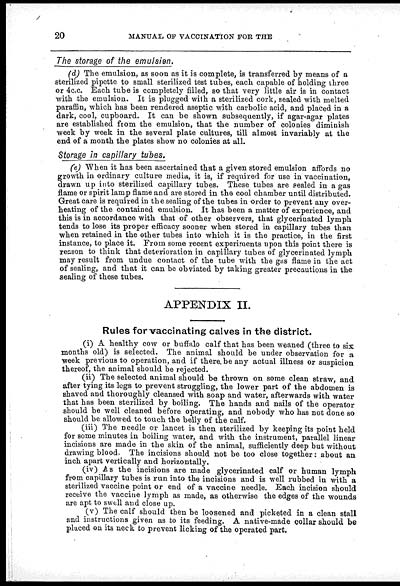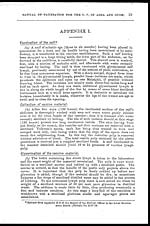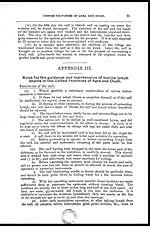Medicine - Vaccination > 1903 - Manual of vaccination for the United Provinces of Agra and Oudh > Manual of vaccination for the United Provinces of Agra and Oudh
(32) Page 20
Download files
Individual page:
Thumbnail gallery: Grid view | List view

20 MANUAL OF VACCINATION FOR THE
The storage of the emulsien.
(d) The emulsion, as soon as it is complete, is transferred by means of a
sterilized pipette to small sterilized test tubes, each capable of holding three
or 4c.c. Each tube is completely filled, so that very little air is in contact
with the emulsion. It is plugged with a sterilized cork, sealed with melted
paraffin, which has been rendered aseptic with carbolic acid, and placed in a
dark, cool, cupboard. It can be shown subsequently, if agar-agar plates
are established from the emulsion, that the number of colonies diminish
week by week in the several plate cultures, till almost invariably at the
end of a month the plates show no colonies at all.
Storage in capillary tubes.
(e) When it has been ascertained that a given stored emulsion affords no
growth in ordinary culture media, it is, if required for use in vaccination,
drawn up into sterilized capillary tubes. These tubes are sealed in a gas
flame or spirit lamp flame and are stored in the cool chamber until distributed.
Great care is required in the sealing of the tubes in order to prevent any over-
heating of the contained emulsion. It has been a matter of experience, and
this is in accordance with that of other observers, that glycerinated lymph
tends to lose its proper efficacy sooner when stored in capillary tubes than
when retained in the other tubes into which it is the practice, in the first
instance, to place it. From some recent experiments upon this point there is
reason to think that deterioration in capillary tubes of glycerinated lymph
may result from undue contact of the tube with the gas flame in the act
of sealing, and that it can be obviated by taking greater precautions in the
sealing of these tubes.
APPENDIX II.
Rules for vaccinating calves in the district.
(i) A healthy cow or buffalo calf that has been weaned (three to six
months old) is selected. The animal should be under observation for a
week previous to operation, and if there be any actual illness or suspicion
thereof, the animal should be rejected.
(ii) The selected animal should be thrown on some clean straw, and
after tying its legs to prevent struggling, the lower part of the abdomen is
shaved and thoroughly cleansed with soap and water, afterwards with water
that has been sterilized by boiling. The hands and nails of the operator
should be well cleaned before operating, and nobody who has not done so
should be allowed to touch the belly of the calf.
(iii) The needle or lancet is then sterilized by keeping its point held
for some minutes in boiling water, and with the instrument, parallel linear
incisions are made in the skin of the animal, sufficiently deep but without
drawing blood. The incisions should not be too close together: about an
inch apart vertically and horizontally.
(iv) As the incisions are made glycerinated calf or human lymph
from capillary tubes is run into the incisions and is well rubbed in with a
sterilized vaccine point or end of a vaccine needle. Each incision should
receive the vaccine lymph as made, as otherwise the edges of the wounds
are apt to swell and close up.
(v) The calf should then be loosened and picketed in a clean stall
and instructions given as to its feeding. A native-made collar should be
placed on its neck to prevent licking of the operated part.
Set display mode to: Large image | Zoom image | Transcription
Images and transcriptions on this page, including medium image downloads, may be used under the Creative Commons Attribution 4.0 International Licence unless otherwise stated. ![]()
| India Papers > Medicine - Vaccination > Manual of vaccination for the United Provinces of Agra and Oudh > Manual of vaccination for the United Provinces of Agra and Oudh > (32) Page 20 |
|---|
| Permanent URL | https://digital.nls.uk/90721531 |
|---|




